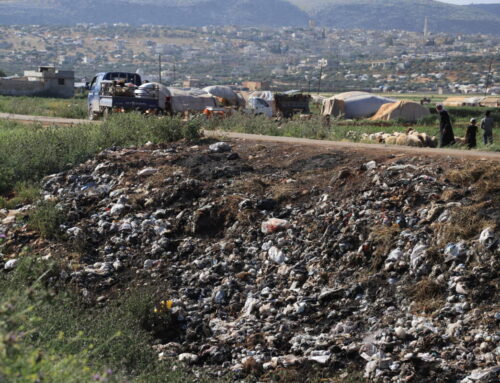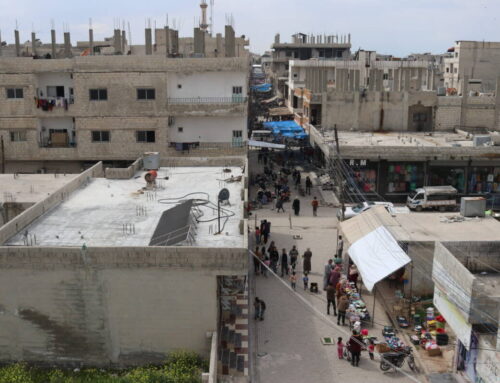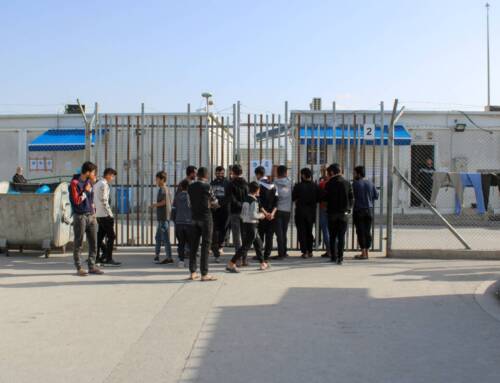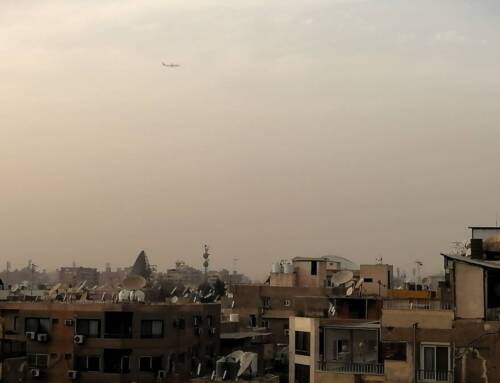Syrian government closes final loophole to tighten siege of east Damascus suburbs
AMMAN: In a rebel-controlled, working-class suburb east of Damascus, Wardeh […]
20 April 2017
AMMAN: In a rebel-controlled, working-class suburb east of Damascus, Wardeh Hamdan is seven months pregnant with her first child, a boy.
But now, one month into an airtight government siege of East Ghouta, a collection of around a dozen bombed-out towns and villages east of the capital, Hamdan and her husband wonder how they will provide their son with baby formula, diapers and vaccines after she gives birth.
“This is what keeps me up at night,” says Hamdan’s husband Ahmad. He is both a freelance journalist with Orient News and a tailor from the central East Ghouta town of Saqba, once known for its furniture factories.
“I don’t want my son to live under this siege.”
The regime encircled East Ghouta in 2012. Since then, the opposition has exploited holes in what appeared, on the outside, to be an impermeable encirclement.
The most critical loophole that kept East Ghouta afloat was a regime checkpoint located near the city of Douma in the region’s north. The al-Wafideen crossing, named after a nearby Palestinian refugee camp, once supplied East Ghouta’s 400,000 residents with the majority of their food and basic goods.
Al-Wafideen is managed by Moheddine al-Manfoush, a wealthy Syrian war profiteer with family connections to the food production and distribution industries. By lining the pockets of government officials, al-Manfoush was, until recently, passing 150 tons of food and other supplies through al-Wafideen daily, Syria Direct reported in March.

“All of us in East Ghouta know who al-Manfoush is,” says Osama al-Amri, who lives in Douma and directs pro-opposition news outlet Shadda Hurriya. “We used to see his cars coming into East Ghouta every day.”
But on March 21, government forces quietly, and without prior notice, shuttered the al-Wafideen checkpoint, erecting earthen berms and “completely closing down the crossing,” al-Amri tells Syria Direct.
“All of a sudden, [al-Manfoush’s cars] stopped coming,” al-Amri tells Syria Direct. “When people found out [the crossing] was closed entirely, they were shocked.”
East Ghouta is now entirely cut off from outside food and supplies for the first time since the regime tightened its encirclement in early 2014. In the hours after the crossing closed on March 21, the price of all goods inside the rebel pocket rose “sharply” and “immediately,” says former journalist Ahmad. “That’s how we knew the crossing was shut.”
Less than a month later, the price of bread, baby formula and other goods has tripled, leaving Hamdan, al-Amri and other East Ghouta residents hungry and unable to afford basic necessities—all while facing government airstrikes.
“We’ve started to run out of food and medicine,” says Ahmad Hamdan. “My son may come into this world as we suffer under a harsh siege,” he says.
‘Abu Ayman’ al-Manfoush
Moheddine “Abu Ayman” al-Manfoush’s products are ubiquitous in the Damascus region, where his company distributes cheese, dairy and other food products to both regime and rebel-controlled areas under the “Al-Marai” brand. Plastered across the front of al-Manfoush advertisements is their English slogan: ‘Is all what I want!’
Al-Manfoush’s family is originally from Misraba in central East Ghouta, where his company still owns several dairy farms. Though personal details on the elusive businessman are scarce, he is reportedly well-connected to high-level officials in both the Syrian government and opposition factions.
A shop in Douma, February 4, 2017. Photo courtesy of Abd Doumany/AFP/Getty Images.
In late 2014, al-Manfoush struck deals between the regime and rebels that permit smugglers to sell food to traders in East Ghouta. Under the agreement, traders buy goods from Damascus at the al-Wafideen checkpoint, then restock their grocery stores—often with al-Manfoush’s own products—in East Ghouta, The Century Foundation reported in December 2016.
Al-Manfoush’s operation has reportedly made him quite wealthy, while at the same time leaving a substantial cut for government officials. In East Ghouta, traders report paying exorbitant bribes to both the government soldiers guarding the al-Wafideen checkpoint and opposition officials.
By the time all parties receive their respective cuts, an item could be sold in East Ghouta for up to 24 times its price in government-controlled Damascus, the London School of Economics reported in 2015.
A ‘far worse’ siege
Before al-Manfoush’s agreement with the regime to supply East Ghouta with food in late 2014, government forces tightly encircled East Ghouta in spring of the same year, imposing a harsh siege on residents. With food scarce and expensive, some residents even began baking bread from animal feed to stave off hunger, pro-opposition SMART News Agency reported in September 2014.
Now, East Ghoutans tell Syria Direct that they fear the coming months could be more devastating than the nearly year-long period of total encirclement in 2014.
In 2014, the area held by rebels in the eastern Damascus suburbs was larger, encompassing several fertile agricultural regions that allowed residents to grow food and mitigate the impact of being cut off from outside supplies.
At the same time, a vast, complex system of tunnels built by rebels in 2013 between eastern Damascus and East Ghouta allowed the opposition to quietly sneak food, fuel and medicine into the besieged enclave. The rebels continued building additional tunnels for commercial and military use throughout the siege of 2014.
But over the past year, the Syrian regime has retaken crucial territory in and around East Ghouta and, in doing so, limited the opposition’s current ability to withstand a total siege.
Last May, the rebels lost the fertile Marj region to East Ghouta’s south, where the bulk of the area’s produce was farmed. It has not been recaptured by rebels since.
This past February, the regime struck another critical blow to the rebels by laying siege to three east Damascus neighborhoods north of East Ghouta that fed supplies into the besieged area via smuggling tunnels.
“We used to have the tunnels bringing in food and medicine,” says Kholoud, a 31-year-old, widowed mother of three from Kafr Batna, a town on East Ghouta’s southern edge. She has lived with relatives since an airstrike killed her husband three years ago. “Now we don’t have anything.”
During the last siege in 2014, “there were grains, vegetables,” says Kholoud. “We no longer have grains, and most vegetables are gone. Lettuce and spinach are all we have left.”
“This siege is far worse than the one three years ago.”
‘Dark days ahead’
Now just weeks from her delivery date in Saqba, Wardeh Hamdan says a number of things are worrying her: the likelihood of cesarean section with inadequate medicine, a widespread lack of vaccines to give her newborn son, and empty store shelves that were once stocked with baby formula.
She hasn’t taken prenatal vitamin supplements at all throughout her pregnancy, as the already scarce supply completely vanished at the onset of the siege one month ago.
“I’m frightened this could have an effect on my baby’s health,” she says.
Hamdan isn’t alone. Nearly a dozen other East Ghouta residents interviewed for this report describe nothing less than “oppressive” poverty and a near total lack of affordable necessities on the ground—including food and medicine—as the closure of al-Wafideen enters its second month.
Selling grain in Douma, February 2017. Photo courtesy of Sameer Al-Doumy/AFP/Getty Images.
Residents describe virtually empty markets in their hometowns across East Ghouta, where shopgoers simply “wander around without buying anything because of the rise in prices” since last month’s closure, says Ahmad al-Baqaai, who directs a medical relief organization in Kufr Batna. “When they do buy something, they are forced to buy just small amounts.”
Among those residents are parents of young children, who say supplies for their families are both low and prohibitively expensive since al-Wafideen closed last month.
Osama al-Amri, the pro-opposition media outlet director in East Ghouta, says that since the closure, he can barely afford diapers, now SP250 [$1.15] each, for his one-year-old son. “That means whoever has a baby needs to pay a minimum of SP500 [$2.30] per day on diapers,” he tells Syria Direct.
Even basic food supplies are too expensive for Kholoud, the young widow living in Kafr Batna with her three daughters. All three girls suffer from a blood disorder that requires a specialized diet. But Kholoud says she cannot afford to buy even “a little bit of flour,” now SP1,000 [$5] since al-Wafideen’s closure, for herself and her children.
One kilo of bread, she adds, has now risen to SP1,000 [$5]—40 times the price in government-held Damascus.
To compensate, Kholoud recently sold off most of her daughters’ clothes “in the hopes of providing food.” Now she feeds herself and her children little more than bulgur, a relatively cheap grain, “as the only daily meal to stave off death.”
Muhannad al-Khateeb, an elementary school teacher in Kafr Batna, stopped buying flour and meat altogether since the closure, and “started cooking on firewood because there is no more gasoline,” he tells Syria Direct. Schools across East Ghouta shut down weeks ago due to government airstrikes, leaving him with no work. Now, he survives on barley, spinach and chard. “There just isn’t enough money to buy food,” he says.
All that is left, says Mohammad Ayman, a young father and citizen journalist in Douma, is “whatever can still be cultivated inside Ghouta.” For him, that means beans, carrots and little else.
East Ghouta’s quietly growing hunger is, residents say, a dark omen for those who watched the Syrian government besiege, starve and eventually recapture similar opposition-run communities elsewhere.
Even al-Amri, who—unlike soon-to-be parents Wardeh and Ahmad Hamdan—still wants to raise his infant son in the encircled pocket, is apprehensive.
“I prefer to stay here with my child and my family in Ghouta, no matter what happens,” he says. “But the signs all point to a siege worse than the one we experienced in 2014.”
“It looks like there are dark days ahead.”







